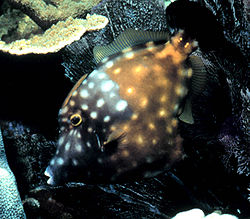This article needs additional citations for verification .(September 2014) |
| Cantherhines macrocerus | |
|---|---|
 | |
| American whitespotted filefish, Cantherhines macrocerus | |
| Scientific classification | |
| Kingdom: | Animalia |
| Phylum: | Chordata |
| Class: | Actinopterygii |
| Order: | Tetraodontiformes |
| Family: | Monacanthidae |
| Genus: | Cantherhines |
| Species: | C. macrocerus |
| Binomial name | |
| Cantherhines macrocerus (Hollard, 1853) | |
Cantherhines macrocerus, commonly known as the whitespotted filefish, American whitespotted filefish, or whitespotted limefish, is a marine fish found along the coast of Florida extending southward into the Caribbean. This species is distinct and separate from Cantherhines dumerilii , the similarly named whitespotted filefish which is found in the Indian and Pacific oceans.


